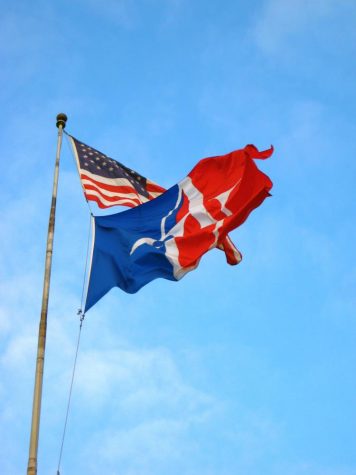No Drones Allowed: How the FAA May Be Holding Back Journalism
On New Year’s Day, Jesse Tinsley headed out to Sanders Beach as he had for the past 12 years. A staff photographer for Washington state’s Spokesman-Review, he intended to capture the Lake Couer d’Alene’s annual Polar Bear Plunge on camera. But instead of using his normal Nikon D-4, Tinsley wanted to try something different.
The DJI Phantom is one of the most popular unmanned aerial systems (UAS), or drones, on the market and Tinsley had owned his for about three months. With the all-white $1,200-kit in tow, he marched past the hordes of swim-clad Idahoans and waited for noon. When the moment came and people rushed into the water, Tinsley’s drone took to the skies, filming the crowd from a vantage point unmatched in his career. He edited the footage later that day.
“When I saw my video I was just tickled with it,” Tinsley said in a phone interview.
So tickled in fact, he took it upon himself to upload the video to the paper’s website, Spokesman.com, that evening. That’s when it began.
Less than a day had passed before a Jeremy Barr, a media writer for the Poynter Institute had learned of the story. He had been following the use of drones in journalism for some time and had one question for Tinsley: _was what he did legal?_
After Twitter discussion with drone expert Matt Waite, the answer was still murky. However, any haze was soon cleared up when a representative from the Federal Aviation Administration (FAA) caught wind.
“There is no gray area” spokesperson Les Dorr told Barr, adding, “if you’re using it for any sort of commercial purposes, including journalism, that’s not allowed.”
Upon reading Barr’s piece, published the next day, Tinsley said he was surprised.
“I read it and I thought ‘Ouch. Those FAA guys don’t fool around.’”
Tinsley and his editor decided to hold off on any more drone stories.
“We left it on the website and said ‘Well, we’re not going to publish anything else [with drones] until the legalities get sorted out,” Tinsley said.
h3. A Game Changer
Matt Waite helms the Drone Journalism Lab at the University of Nebraska-Lincoln’s College of Journalism and Mass Communication. Once a reporter for the St. Petersburg Times, and developer for the Pulitzer Prize-winning website, PolitiFact, Waite began exploring the intersections of unmanned aircraft technology shortly after returning to teach at UNL.
To Waite—who during his time as a reporter covered floods, tornadoes and all sorts of what he dubs “biblical events”—the advantages of drones had always seemed like a vision.
“Even back in the golden age of journalism when profit margins were their fattest, you couldn’t just walk down to an airport and say ‘Let’s rent a helicopter.’ You’d run up three thousand dollars worth of bills just flying around.”
But at a digital mapping conference in 2011, that vision became a reality. On display was the Gatewing X100, a mapping drone that can take pictures of any territory without even needing a remote control.
“I was floored,” Waite said. “My mouth was open.”
He lobbied the dean for a lab to study drones and began operations in Nov. that year. They published their first drone-incorporated story on the Platte River’s record-breaking drought in Oct. Filming on public, rural land under the hobbyist restrictions of below 400 feet and in plain sight, the group thought they were in the clear. But 13,000 views and eight months later, the FAA’s cease and desist letter finally showed up.
“When I first got it, I kind of freaked out a little bit, because it’s a certified cease and desist letter from the federal government,” Waite said. “That’s just not something you get everyday.”
The agency said that as an employee of a public institution, Waite must follow the rules that other government entities must follow—namely, forgo the commercial use of drones.
From then on, Waite decided he would consign the focus of the lab to study policy and innovation surrounding drones, rather than reporting with them.
Both Tinsley’s and Waite’s stories highlight what many in the field of journalism see as missed opportunities incurred by the slow grind of the FAA’s regulatory process. Around the country, each week brings a new instance of agency sanctions as people try to use the ever-cheapening technology for commercial purposes.
h3. Law, or Memo?
With the recent suspension of a Connecticut news reporter flying a drone at the scene of a car crash, drone-based businesses being denied licenses, and a bevy of cease and desist letters, the FAA’s staunch position has led to various lawsuits challenging their anti-commercial policy.
Chief among them is the ongoing case of Raphael Pirker vs. FAA. Pirker, known under the moniker, “Trappy,” is the world’s most famous (and perhaps most daring) drone operator. The founder of Team Black Sheep—a part-retailer, part-advertisement firm, and part-hobby group— Trappy has dazzled millions with his stunning videos of flights around New York City, New Zealand, and the Costa Concordia shipwreck.
Where some would say he erred was in 2011, when he filmed a paid advertisement for University of Virginia’s School of Medicine. The resulting YouTube clip shows Pirker just barely avoiding the dome on the famous campus building ‘The Rotunda,’ and diving below a heavily trafficked overpass. The FAA fined him $10,000.
Brendan Schulman, Pirker’s lawyer, says the FAA’s policy of no commercial drone flying is “not enforceable.” He says because the rule, which was first iterated in a 2007 statement from the FAA, never went through the proper procedure to become law.
“One of the bedrock principles of the [Administrative Procedures Act] is that agencies don’t just make up rules as they go and tell you from one day to the next what the new law is,” Schulman said. “The agencies go through a notice and comment rule making process.”
The FAA, who could not be reached for comment, has recently unveiled testing sites for unmanned aerial systems that will lay the groundwork for future rulemaking.
In a 70-page “roadmap” on UAS, the agency describes how it will incorporate civilian drones into the National Airspace System (NAS) by Sept. 2015. However, as both Schulman and Waite note, the plan hardly mentions the fate of small UAS under 55 pounds, saying only that the Notice of Proposed Rulemaking is “expected to be released in early 2014.”
“The technology is so far out ahead of the regulation it is blindingly obvious to anyone who uses these devices,” Waite said.
Meanwhile, Pirker’s case is pending a hearing from the National Transportation Safety Board which will decide whether or not to grant Schulman’s motion to dismiss.
h3. Just the First Step
Since bureaucratic limbo has dominated the discussion of the use of drones in journalism, Waite says that the question of what this means for the profession has been all but glossed over.
He recalls the night of a double murder when he was a reporter for the St. Petersburg Times. He arrived at the scene around the same time as the police. Years later, Waite says he can still here the cries of the mother as she looked at the bodies of her slain twin boys. He says the buzzing of drones filming from overhead would compound that horrific scenario.
“I don’t think that’s going to win us any friends at all in the marketplace,” Waite said. “I don’t think journalists will be more respected if that’s the kind of behavior that’s going to happen.”
Or take for instance a Syrian refugee camp, he says.
“Imagine now you have tens of thousands of people displaced by war and you are now going to fly this robotic looking thing with a camera on it that people instinctually identify with the military.”
“The FAA is just the first step,” Waite said. “The question then immediately shifts to: because we can, should we?”












